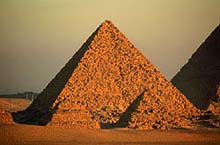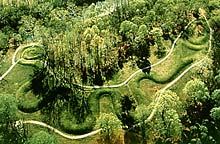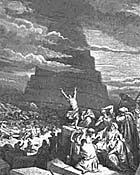|
|


Editorial
|
Fragments
|
Cahokia II
|
Piasa Creature II
|
Sphinx III
Register
for our Hall of Records Newsletter!
Questions? Comments? Suggestions? Advertising? Press Releases?
Contact us!


The "Pyramid of Menkaure", the smallest of the three great pyramids. This pyramid is believed
to have been built by Pharaoh Menkaure around 2500 b.c. The three lesser pyramids (foreground)
are believed to be the burial tombs for his queens.
|
|
The Pyramid of Menkaure, built around 2500 b.c. by Pharaoh Menkaure, the son of Khafre,
the builder of the second pyramid. The last of the three major pyramids, the pyramids
of Khufu (the "Great Pyramid"), Khafre, and Menkaure, this "third pyramid" is just one-
tenth the size of the other two pyramids of the Giza group.
Menkaure's pyramid was left unfinished, perhaps because, some speculate, Menkaure died
before its construction was complete. As such, the lower courses of the pyramid are
encased in granite blocks, whereas the upper courses were left rough hewn and uncovered.
It may also be possible that the granite blocks had fallen off due to earthquakes in
the region, and carried away by locals for use in construction. The two other Giza pyramids
show signs of also having been encased in granite. The pyramid of Khufu still has some
granite facing stones scattered about its surface, and Khafre actually has retained the
granite facing stones on much of its peak. If this is true, then the pyramids, far from
being the rough-hewn, jagged, yellow-orange rockpiles that they appear as today, were in
their heyday smooth, gleaming white symbols of geometrical perfection.
By far the most asked question about the pyramid of Menkaure, however, is, "Why is it so
much smaller than the others? Most archaeologists have been of the opinion that Menkaure's
pyramid represented a decline in Egyptian pyramid-building expertise, a decline in the
amount of funds available in the royal treasury, or both. However, in 1995 a Belgian architect
and amateur astronomer by the name of Robert Bauval noticed that from above, the three pyramids
of Giza closely resembled in layout the belt stars of Orion. Not only did the relative
positioning of the pyramids match, but the relative sizes of the pyramids matched the
relative intensity of the three belt stars (click
here
for more).



|
|
|


Serpent Mound, near Peebles, Ohio. Serpent Mound is the largest and best-known serpent effigy
in North America.
|
|
The lush, green, rolling hills of southern Ohio is the perfect location for Serpent Mound,
the largest effigy mound in North America. Serpent Mound is the most famous of the numerous
serpent-shaped effigy mounds in North America, and is also one of the oldest. However,
though it is over 1,300 feet long, it averages only 3 feet in height, and it is difficult
to see from the ground.
Set in the heart of the lush, rolling hills of southern Ohio, there is little question
as to why the prehistoric Adena Indians (800 b.c. — a.d. 100) chose the Serpent symbol to
represent the spirit of the area. The gently rolling hills of Adams County are clearly
reminiscent of the undulating coils of a serpent, and of the fertility that the serpent
represented in ancient Native American religion. Set deep in the countryside of southern
Ohio, Serpent Mound and Adams County in general are a welcome relief from the hustle of
Dayton and Cincinnati.
Though little details are known regarding the religious beliefs and rituals of the Adena,
many believe that the Serpent Mound sat at the center of their religious rituals, and
may have even served as a pathway for practitioners to walk, chanting hymns and thanking
their gods for the continued fertility of the land, and praying for its continuance.
The serpent's 17-foot jaws seem to be swallowing an egg, a somewhat disturbing image,
yet not atypical of snakes, which often do eat bird eggs whole.
Nearby mounds have yielded significant archaeological discoveries from the Adena peoples,
many of which are on display on site at the Serpent Mounds Museum. Serpent Mound is on
State Route 73, six miles north of State Route 32 and 20 miles south of Bainbridge in
Adams County, Ohio, near the town of Peebles. For more information, call 937-587-2796,
or visit
http://www.ohiohistory.org/places/serpent/



|
|

|


Dore's classic rendering of the "Tower of Babel" event recorded in Genesis 11.
Most scholars believe that the tower was more like a ziggurat in form, a stepped tower similar
in design to those built by the ancient Maya and other Southern and Central American peoples.
|
|
In Genesis 11, there is a strange story about how the ancient Babylonians decided to build
a city, with a tower that would somehow unite mankind. "Come, let us build ourselves a city,
with a tower that reaches to the heavens, so that we may make a name for ourselves and not
be scattered over the face of the whole Earth" (Gen. 11:4). God feared that the building of
this tower would unite mankind, so he confused their languages, thus ending any possibility
of a united rebellion against him, as their confusion of languages made it impossible to
undertake any sort of coordinated action. Thus, it was named the "Tower of Babel", from
which our modern word "babble" is derived.
Scholars are divided on exactly what the tower was, and where it was located. Some believe
that it is one of the many ziggurats to be found in Babylon today, others believe that it
was destroyed, either in the chaos following the breakdown of society caused by the
confusion of tongues, or some other undetermined cause. Unfortunately, due to the reign of
Saddam Hussein, Western archaeological research had been curtailed in the area, so further
research into the exact nature of the tower of Babel has been impossible.
With the conquest and liberation of Iraq, however, new research will likely start soon into what truly happened
in the dim past of humanity. Stay tuned to Mysterious World for regular updates on new discoveries regarding humanity's true past.



|
|
|


Angkor Wat, in modern-day Cambodia. This ancient ruin is actually fairly recent, built on
the remains of a far more ancient structure. Angkor Wat is still in use today.
|
|
The temples of Angkor Wat in Cambodia are some of the most enigmatic structures to be found
in Asia. Construction on the temples was started by the ancient Khmer king Jayavarman II
around a.d. 800, and the building and maintenance of Angkor was continued by his ancestors
for the next 600 years, before they were forced out of the area by the Thai around 1431.
Angkor Wat is an exceptional monument on many levels. First of all, in size and complexity it
ranks with all other major archaeological sites in the world, including even the pyramids
of Egypt and Mexico. Moreover, its layout is like a mandala, i.e., a symbolic, ritualistic
pattern intended to teach those who view it to think in a certain pattern. Academics who
study the layout of Angkor Wat are of the opinion the layout of Angkor is intended to
communicate the Buddhist view of the universe, and Buddhist monks still visit Angkor for this
purpose.
Another view that has recently been discovered is that of Angkor Wat as a representation of
the constellation of Draco on earth. Like the pyramids and Orion, Angkor Wat is believed by
some to be laid out in such a way as to imitate the stars of the constellation of Draco,
which lies near the pole star. Some believe that this indicates that Angkor Wat was actually
started centuries earlier, and Jayavarman merely built up and improved pre-existing
structures. If so, it is possible that the original ruins may have been significantly older,
possibly dating back to the time of the pyramids.



|
|
Editorial
|
Fragments
|
Cahokia II
|
Piasa Creature II
|
Sphinx III
Register
for our Hall of Records Newsletter!
Questions? Comments? Suggestions? Advertising? Press Releases?
Contact us!



 Lost Cities of North and Central America
Lost Cities of North and Central America
David Hatcher Childress
Rating:
   
One of the popular "Lost Cities" series, this book is a must-have guidebook for mysterious
places in North and Central America. I enjoy Childress' books mainly because he comes across as very honest,
although he engages in too much speculation to be taken at face value. Overall
I find his books a very engaging read, and the speculative aspect, though often
unscientific, is very entertaining. Moreover, the amazing amount of study and
travel he has done brings a certain amount of credibility to his work. I highly
recommend the "Lost Cities" series of books both for their refreshingly informal
approach and for their "infotainment" value. These books are definitely
not for the timid, and certainly not for the closed-minded.
Click
here
to buy this book.
 Lost Cities of Atlantis Ancient Europe & the Mediterranean
Lost Cities of Atlantis Ancient Europe & the Mediterranean
David Hatcher Childress
Rating:
   
One of the popular "Lost Cities" series, this book is a must-have guidebook for mysterious
places in Europe.
Click
here
to buy this book.
 Lost Cities of Africa and Arabia
Lost Cities of Africa and Arabia
David Hatcher Childress
Rating:
   
One of the popular "Lost Cities" series, this book is a must-have guidebook for mysterious
places in Africa and Arabia.
Click
here
to buy this book.


 Passion: Music for the Last Temptation of Christ
Passion: Music for the Last Temptation of Christ
Peter Gabriel
Rating:
    
This CD received superb reviews (5 stars) and is personally recommended by the publisher.
(The background music on this page is from "Zaar", the eighth track of this CD.)
Click
here
to buy this music.
Editorial
|
Fragments
|
Cahokia II
|
Piasa Creature II
|
Sphinx III
Register
for our Hall of Records Newsletter!
Questions? Comments? Suggestions? Advertising? Press Releases?
Contact us!
|

|
|
|


